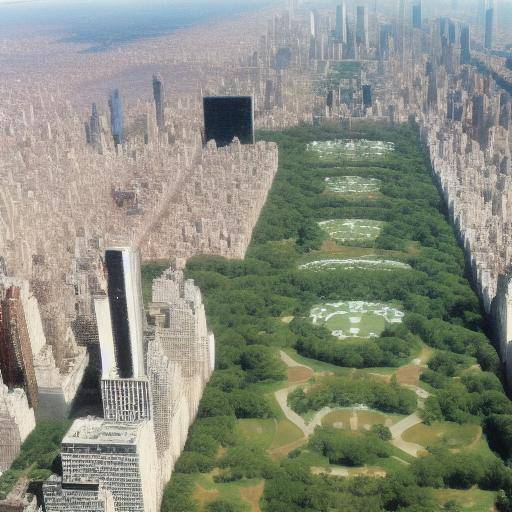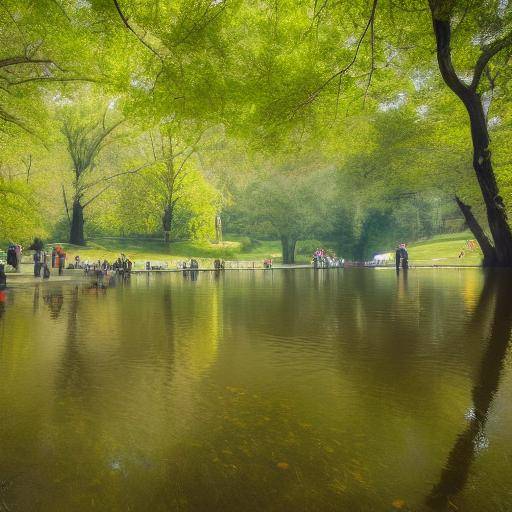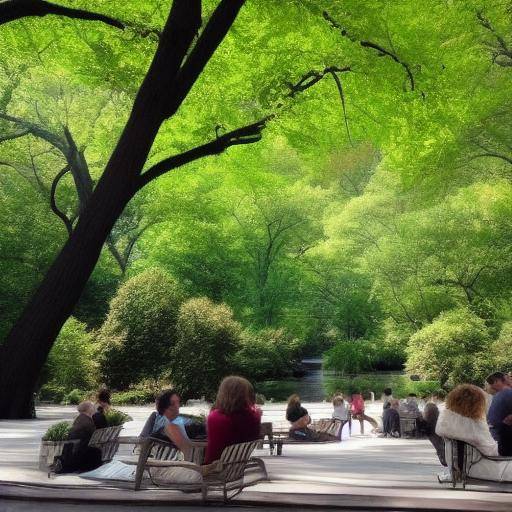
Introduction
From its conception as an ambitious project to its evolution as a cultural and natural icon, the Central Park of New York has witnessed a rich history that has left a profound mark on the urban landscape. This article seeks to explore in depth the history of Central Park, its meaning in New York history and its role as landscape heritage. Throughout these pages, we will discover the origins of this emblematic park, the key figures that have shaped its evolution, its impact on the city and the future trends that surround it. This article will be an immersion in history, urban design and landscape evolution surrounding Central Park, providing a careful analysis of its importance both locally and globally.
History and Background
Since its opening in 1858, Central Park has been an urban oasis in the heart of the bustling city of New York. His avant-garde design, by landscape architect Frederick Law Olmsted and the British architect Calvert Vaux, revolutionized the conception of green spaces in urban environments. His conception took inspiration from European parks and became a milestone in the history of urban design.
Central Park has witnessed numerous historical events over the centuries, from its use as a refuge during the American Civil War to its role in promoting social reform and community empowerment. Its legacy endures as a living testimony of human capacity to shape nature and make it accessible to future generations.
Deep analysis
Central Park has been the scene of multiple ups and downs throughout its history. From periods of decadence to its rebirth as the centre of cultural and social life in New York, the park has reflected the challenges and triumphs of the surrounding city. Their impact on the mental and physical health of their visitors, as well as their role as an economic engine, demonstrate their multifaceted influence in the community.
The management and preservation of the landscape heritage of Central Park has been a subject of constant debate and evolution. The search for a balance between the conservation of its natural beauty and the adaptation to modern needs has led to innovations in sustainability and design. The commitment to preserve its original essence while adapting to contemporary demands is a constant challenge that continues to shape its evolution.
Exhaustive examination
The impact of Central Park on urban design trends, sustainable tourism and community empowerment makes it a transgressive benchmark that transcends New York's physical borders. His legacy has inspired similar projects around the world, reflecting his influence on the modern conception of green spaces in urban environments.
Comparative analysis
By comparing Central Park with other urban green spaces, significant differences are revealed in its design, design and evolution. The cultural and social narrative surrounding Central Park distinguishes it as a unique microcosm of New York history, highlighting its role as a crucible of identities and intertwined stories. His legacy as landscape heritage transcends his mere physical existence, acquiring a symbolic meaning that makes him a beacon of inspiration for the future of cities.
Practical Tips and Accessible Tips
For those who wish to explore Central Park in a deeper way, it is recommended to start with a visit to its iconic sites, such as the Bethesda Terrace, the Bow Bridge and the Ramble. Entering into its vast expanse of meadows and forests offers an experience that goes beyond merely the tourist, allowing an immersion in its rich history and its role in the daily life of the city.
Industry Perspectives and Expert Reviews
The perspectives of the experts show a consensus around the unique value of Central Park as a monumental achievement in urban design and sustainable management of urban green spaces. Its ability to merge nature and architecture in perfect harmony is unquestionable, serving as a model to follow for the development of future landscape projects.
Case Studies and Applications in Real Life
Several case studies show how Central Park's influence extends beyond New York, inspiring urban revitalization and sustainability initiatives in cities around the world. Their approach to integrating nature into the built environment has been replicated in community revitalization and urban development initiatives on various scales.
Future Trends and Predictions
Future trends suggest a renewed approach to human connection with nature and the promotion of urban green spaces as vital elements for the well-being of communities. Central Park will continue to serve as a beacon of inspiration for future initiatives, promoting a holistic approach to urban design and sustainable management of green spaces.
Conclusions and FAQs
In conclusion, the history of Central Park in New York reflects a legacy of innovation in urban design and the management of green spaces, highlighting its importance as a landscape heritage at the local and global levels. Its evolution and cultural legacy continue to inspire generations, showing that, beyond its mere physical existence, Central Park is a living testimony of the ability to transform urban environments into spaces that transcend time and history.
Frequently asked questions
**What is the importance of Central Park in New York history?**Central Park has played a crucial role in New York history by providing a natural shelter in the midst of an urban environment, promoting the health and well-being of its citizens, and serving as a focal point for the social and cultural life of the city.
**How has Central Park adapted to modern needs?**Central Park has implemented innovative measures in sustainability and design to adapt to modern needs, preserving its original essence while incorporating contemporary solutions for the enjoyment of visitors.
**How has Central Park influenced global urban design?**The influence of Central Park in global urban design is undeniable, serving as a model for integrating nature into urban environments and promoting a holistic approach to the sustainable development of urban green spaces.
**What are the current challenges facing Central Park in terms of management and preservation?**Some of the current challenges facing Central Park include the preservation of their unique ecology, the management of tourism visits and adaptation to climate change, which requires a holistic approach to sustainability and conservation.
**What is the cultural and social legacy of Central Park in New York City?**The cultural and social legacy of Central Park is manifested in its role as a crucible of identities and experiences, promoting inclusion and human connection with nature, enriching the lives of its visitors and the surrounding community.
**What are the future trends expected in the development of urban green spaces, influenced by the history of Central Park?**Future trends in the development of urban green spaces will be marked by a renewed approach to human connection with nature, promoting community well-being and environmental sustainability, influenced by the history and legacy of Central Park.
In short, New York Central Park represents much more than an urban park. It is a symbol of innovation and sustainability, a cultural and social legacy that transcends generations, a beacon of inspiration for urban design and sustainable development at the global level. From its conception to the present, the history of Central Park remains a living testimony of human capacity to transform urban environments into spaces that not only satisfy physical needs, but also enrich the soul and the spirit.
In its historical trajectory, Central Park has left an indelible mark, a footprint that survives in the world's most emblematic city and continues to inspire the creation of green spaces, integration with nature and sustainable development in cities. Its evolution has been the reflection of the very evolution of society, adapting to the times and challenges to remain an icon of harmony between nature and man.
In this article, we have explored the history of Central Park in New York, its influence in the city, its role as landscape heritage and its projection to the future. We hope that this journey through history, urban design and landscape evolution around Central Park has provided an enriching vision and inspiring perspectives on one of the most emblematic parks in the world.


